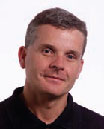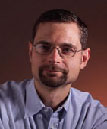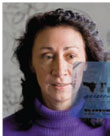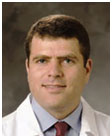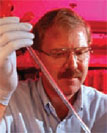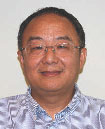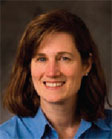Critical needs for philanthropy
The leading edge of cancer research is a tricky place to be. Our researchers are as close to major discoveries as anyone in the world. But large-scale funders government, foundations, corporations face pressures that typically make them reluctant to invest in the boldest, most innovative ideas. |
The impact of philanthropy
Duke Research Profiles...
| ||
|
Donald McDonnell is on the verge of a potential breakthrough in breast cancer treatment. | ||
| The growth of most breast cancer is stimulated by the hormone estrogen. Thus, drugs that either block the production of estrogen or inhibit its actions have become front-line therapies in the treatment of breast cancer. The McDonnell laboratory is specifically interested in defining why most tumors initially respond very well to the anti-estrogen drug tamoxifen but then rapidly become insensitive to it. More than fifteen years ago, Dr. McDonnell and his researchers began developing strategies to address this problem. Their exploration began following the publication in 1988 of an article on tamoxifen resistance by Dr. Craig Jordan (currently a vice chairman of oncology at Georgetown University). "In 1988, Craig Jordan observed that tamoxifen initially inhibited the growth of certain breast cancers in animal models but that, over time, in inhibitory actions of this drug were lost and the tumors grew rapidly," says Dr. McDonnell. "The surprise was not that the drug 'failed' but that the tumors had adapted in such a way that the drug itself began to promote rather than inhibit tumor growth. Our lab set out to determine how this transformation occurred and whether drugs could be developed to block this process or to treat cancers that had failed tamoxifen." When McDonnell's team started their studies, it was generally believed that tamoxifen worked by directly binding to the estrogen receptor in breast cancer cells, "locking" this receptor in an "off" position. However, in an elegant series of scientific papers, they showed that this receptor adopted a novel shape when bound to tamoxifen. They also noted that cells could adapt over time so that they were able to recognize the shape of the tamoxifen-bound estrogen receptor as "on," and therefore the drug lost its effectiveness. Using a very innovative approach they then identified a series of drugs to combat this problem and showed that they were extremely effective inhibitors in mouse models of tamoxifen-refractory breast cancer. The dramatic response in this model convinced Dr. McDonnell's team to bring one of these drugs forward for clinical evaluation, where signs of efficacy were observed in heavily pretreated breast cancer patients. They have now identified a second generation of drugs with improved inhibitory activities and are in the process of selecting the best of these for further research in patients. "We know a lot about the mechanism of action of this new class of drugs, and we believe that they will be useful in the treatment of metastatic breast cancer," says Dr. McDonnell. "For this reason we are eager to get them into the clinic where they are urgently needed." |
| ||
|
Chris Counter and his research assistants have been tackling pancreatic cancer -- "the worst of the worst," as he puts it. In fact, almost no progress has been made against this disease in a decade. The most recently approved therapy for pancreatic cancer extends life expectancy by a mere two weeks. | ||
| Still, there is hope. Dr. Counter explains that "90 percent of pancreatic cancers result from mutations in one particular gene, called RAS, so we know where to focus our research." Although RAS itself has not proven responsive to drugs, Dr. Counter's lab has discovered that the enzyme eNOS is critical to the way RAS promotes pancreatic cancer. This means that it’s theoretically possible to undermine RAS by targeting the eNOS enzyme. Even more encouraging, studies into septic shock not cancer have led to the development of a drug that inhibits NOS enzymes. "This is one of those fortuitous instances where research into other diseases can have a direct impact on oncology research," says Dr. Counter. "The fact that there is a drug against NOS enzymes shaves decades off of translating this discovery into a clinical trial in the area of pancreatic cancer," says Dr. Counter. "We have a drug, we have good evidence that it delivers anti-tumor activity in the lab, and there are dedicated clinicians willing to evaluate this drug in a clinical trial. Philanthropic support would make such a trial reality." |
| ||
|
Ann Marie Pendergast is an international leader in research involving liquid tumors leukemias in particular. For much of her career, she has focused on a particular class of enzymes, named the ABL kinases. She has built on ground-breaking research which suggested that targeting an active form of the ABL kinase, BCR-ABL, can successfully treat certain leukemias. | ||
| "Early on, it appeared that one specific drug could actually cure leukemia," says Dr. Pendergast. "But eventually, patients began experiencing resistance to the drug, and their cancers returned. Through the work of my laboratory, we now understand a great deal more about BCR-ABL and its role in blocking the spread of certain types of cancer cells. Dr. Pendergast and her team have recently arrived at two unexpected and promising conclusions, which required significant funding in order to be tested and proven:
|
| ||
|
David Kirsch is both a scientist and a medical doctor specifically an oncologist who uses radiation therapy to cure cancer. Routinely, his work moves between the laboratory bench and the patient bedside, so he explores cancer through the lenses of a researcher and a clinician. In his work with patients, he deals with the limitations of cancer surgery on a daily basis. | ||
| "When we remove a cancer, we typically remove some of the surrounding tissue as well so the pathologists can examine it and determine if all of the diseased cells have been removed," Dr. Kirsch explains. "We know that, in a quarter to a third of all patients, we will have missed some cancer cells but we have no way of knowing who those patients are until we receive post-operative pathology reports. When those reports return positive findings, we may have to operate again on these same patients, a traumatic situation for all involved." Dr. Kirsch has recently used support from the Damon Runyon Cancer Research Foundation to address this challenge. Specifically, he has developed a process that should enable surgeons to find cancer cells in tissue surrounding a tumor site while the patient is still in the operating room. The process involves injecting fluorescent molecules that are activated by residual cancer cells and then using a novel imaging device to find them. If approved, this process may enable surgeons to identify the millions of patients with residual cancer cells and remove them without follow-up surgery. Unfortunately, Dr. Kirsch has reached a roadblock to test this technology in human populations. "My instincts and my clinical experience tell me that this technology has the potential to be an enormous, practical, pain- and life-saving advance in oncology treatment. But without funding, my research associates and I will never be able to prove this." |
| ||
|
For years, Patrick Casey's research has focused on the role certain proteins play in cancer development. Among his many research accomplishments, Dr. Casey discovered that the RAS gene, a critical player in the development of cancer, is modified by a process known as prenylation. | ||
| More recently, as an administrator he has brought Duke Medicine's practice, reputation and reach onto the global stage. In 2005, Dr. Casey was tapped to create and lead the research programs of Duke-National University of Singapore (Duke-NUS) Graduate Medical School. "Many organizations claim to value 'out of the box' thinking, but few really commit themselves to it and figure out how to make it work but Duke Medicine has," says Dr. Casey. "The leaders of this institution realized the enormous value of global cancer research and invested strategically to turn an opportunity in Singapore into real advances in oncology and other therapeutic areas. We are in our early days in Singapore, but we are already beginning to see many promising returns on our direct, daily engagement with international colleagues in Southeast Asia." Dr. Casey explains that there are interesting and important advantages to conducting basic oncology research in Singapore. For example, certain cancers are more prevalent or behave differently in Asian than in U.S. populations. Working with the National University of Singapore and the Singapore Health System, including the National Cancer Center, Dr. Casey and his researchers have access to different kinds of data and patient populations than are available in the U.S. The international perspective brings other benefits that are harder to quantify. "So much of the success of cancer research comes from the ability to combine varied approaches in uncustomary ways to look at oncological problems from multiple perspectives. It is impossible to identify in advance the discoveries and breakthroughs that will come from our collaboration with colleagues in Singapore, but I am confident they will light up the field in ways we cannot anticipate. That is the excitement and beauty of scientific research." |
| ||
|
"Few people die from their original cancer," says Xiao-Fan Wang. "Ninety percent succumb to metastases that spread from the original cancer. If two people receive the same treatment for their original cancer, one may live for 10 or more years, while the other may lose the battle in two. Because we know so little about how cancer spreads, we are unable to anticipate which patients will survive long-term and which will not." | ||
| In their efforts to understand the spread of cancer within the body, Dr. Wang and his research associates have discovered two important clues. First, it's not easy for a cancer to spread: a primary tumor may throw millions of cancer cells into the circulatory system, but only one or two will take hold and develop into a secondary cancer. Second, cancers seem to be able to develop their own "microenvironments" to improve their ability to spread and grow in new tissues or organs. Because of his connections with Chinese scientists and oncologists where liver cancer is far more prevalent than in the U.S. Dr. Wang has been able to explore the molecular nature of tumor microenvironments and the biochemistry of metastasis in liver cancer. (While more prevalent in Asia, liver cancer is increasing in the U.S. at an alarming pace due to alcoholism and hepatitis infection.) To address these challenges, Dr. Wang has been able to integrate the advanced research capabilities of American scientists with the extensive data on liver cancer available through Chinese research. His work has led him and his assistants to focus on a class of immunosuppressants called "T-regs." The bodies of some patients recruit T-regs in order to create Microenvironments that enable cancer cells to escape the immune system’s ability to block the spread and growth of cancer cells. Because this is such a novel approach to cancer research, Dr. Wang is challenged to secure governmental or institutional funding to make rapid progress in this area. |
| ||
|
Corinne Linardic is a pediatric doctor and also in the early stages of her career as a cancer researcher. Her lab is only two years old and is focused on finding a treatment for rhabdomyosarcoma, a rare cancer that affects about 350 U.S. children per year. In certain high-risk groups, survival is only eight percent at five years. | ||
| "Working at the bedside and in the lab is a special opportunity and a unique challenge, especially when your patients are children with low chances of survival," says Dr. Linardic. "It's a rare disease, which means the funds are scarce and the research is not well developed. But it creates a binary relationship between me and my patients. I look at them and their families and see two options: give up or get moving. I choose to do all I can so that, one day, this grief will be over." Unfortunately, young researchers face a common challenge: without a well-established track record, it's uncommon for them to receive governmental funding or grants. Dr. Linardic's challenge is compounded because rhabdomyosarcoma affects relatively few people. In cases like these, philanthropy is sometimes the only source for research funding and the development of new treatment options. |




